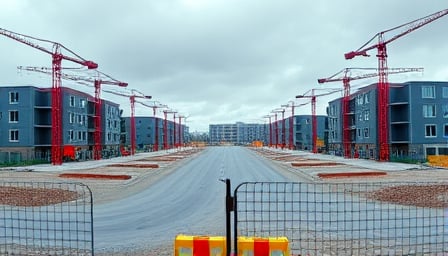KB Home Faces a Crucial Turning Point as the Housing Market Shifts
The latest episode in KB Home’s (NYSE: KBH) saga begins with the grand opening of a new community in Converse, Texas—an event that, on its face, signals continued expansion. Yet the broader backdrop paints a far more complex picture: the company is about to report its Q3 earnings while the sector grapples with margin pressure, muted housing starts, and a Federal Reserve that has just re‑started rate cuts.
1. The New Texas Community: A Symbol or a Signal?
On 19 September 2025, KB Home announced the inauguration of its newest development in Converse, Texas. The press release, sourced from feeds.feedburner.com, frames the event as a milestone that underscores the company’s commitment to first‑time and first‑move‑up buyers—its core market segment. The community’s launch is a concrete demonstration of KB Home’s operational reach across multiple U.S. states.
However, the announcement comes at a time when the company’s valuation is already under pressure. With a close price of $63.94 and a market cap of $4.351 billion, KB Home trades at a price‑to‑earnings ratio of 8.34, a figure that reflects modest earnings relative to its peers in the consumer discretionary sector. The new Texas development, while a marketing triumph, may not be enough to offset the structural challenges that the company faces.
2. Earnings Outlook: Expectations and Uncertainties
The market’s attention has already shifted to KB Home’s forthcoming Q3 earnings. Finviz.com highlighted “Wall Street’s Insights Into Key Metrics Ahead of KB Home (KBH) Q3 Earnings” on 19 September, suggesting that analysts are scrutinizing the company’s financials more closely than ever.
Compounding the scrutiny, Seeking Alpha’s “Earnings week ahead” piece on 21 September lists KB Home alongside other household durables names such as ACN, BB, MU, and COST. This clustering implies a broader concern about the housing market’s health and its impact on builders’ profitability.
The timing of the earnings report—just days after the Texas opening—creates a narrative tension. Investors will be looking for whether the new community can deliver the projected cash flow needed to lift the company’s earnings trajectory, especially given the company’s modest 52‑week low of $48.90 and a high of $89.45 recorded a year earlier.
3. Comparative Weakness: Lennar’s Mixed Results Cast a Shadow
Lennar (NYSE: LEN), a direct competitor, released its Q3 results on 19 September. Reuters’ report on the day’s earnings noted that Lennar “missed revenue expectations but beat EPS.” However, the company’s softer Q4 guidance, coupled with declining margins, has dampened market sentiment.
TheStreet’s commentary on the same day highlighted Lennar’s margin concerns and linked them to broader housing sector risks. It pointed out that “homebuilders embrace incentives to sustain momentum,” yet these measures have not translated into healthy profitability. The negative market reaction to Lennar’s earnings—shares falling—has reinforced a cautionary stance toward the entire sector, including KB Home.
This comparison is crucial: KB Home cannot simply rely on a single new community to offset the negative market perception that has been reinforced by Lennar’s results. The sector’s margin compression, driven by incentive programs and lower demand, poses a systemic risk that could erode KB Home’s earnings even if the Converse community performs well.
4. Monetary Policy as a Double‑Edged Sword
Reuters’ “Wall St Week Ahead” article on 19 September shed light on a pivotal development: the Federal Reserve has restarted rate cuts after a prolonged pause. The central bank’s decision to lower its benchmark rate for the first time since December signals an attempt to buoy a shaky labor market and stimulate economic activity.
For housing shares, this monetary easing is a potential boon. Lower rates could translate into more attractive mortgage terms, thereby boosting demand for new homes. However, the historical pattern suggests that such stimulus often lags, and the housing market’s reaction to monetary policy is muted compared to other interest‑rate‑sensitive sectors.
Moreover, the Fed’s cuts may further erode the profitability of builders by compressing the spread between construction costs and sale prices. If construction costs rise faster than the price premium that builders can command, margin pressure will intensify, as Lennar’s results already hint.
5. The Bottom Line: A Cautionary Narrative
KB Home’s recent community opening, while noteworthy, is eclipsed by a confluence of risk factors:
- Margin Compression – As Lennar’s Q3 results show, incentive‑driven sales strategies are not sustaining healthy profits.
- Earnings Uncertainty – Analysts are primed for a Q3 report that could confirm or dispel concerns about revenue growth and cost management.
- Fed’s Monetary Policy – Interest‑rate cuts may stimulate demand but could also squeeze builder margins.
In an environment where the 52‑week low of $48.90 has already tested the stock’s resilience, the forthcoming earnings report will be the decisive moment. Investors must weigh the symbolic significance of the new Converse community against the stark financial realities that define KB Home’s operating landscape.
